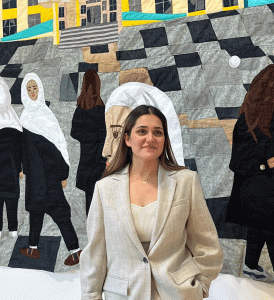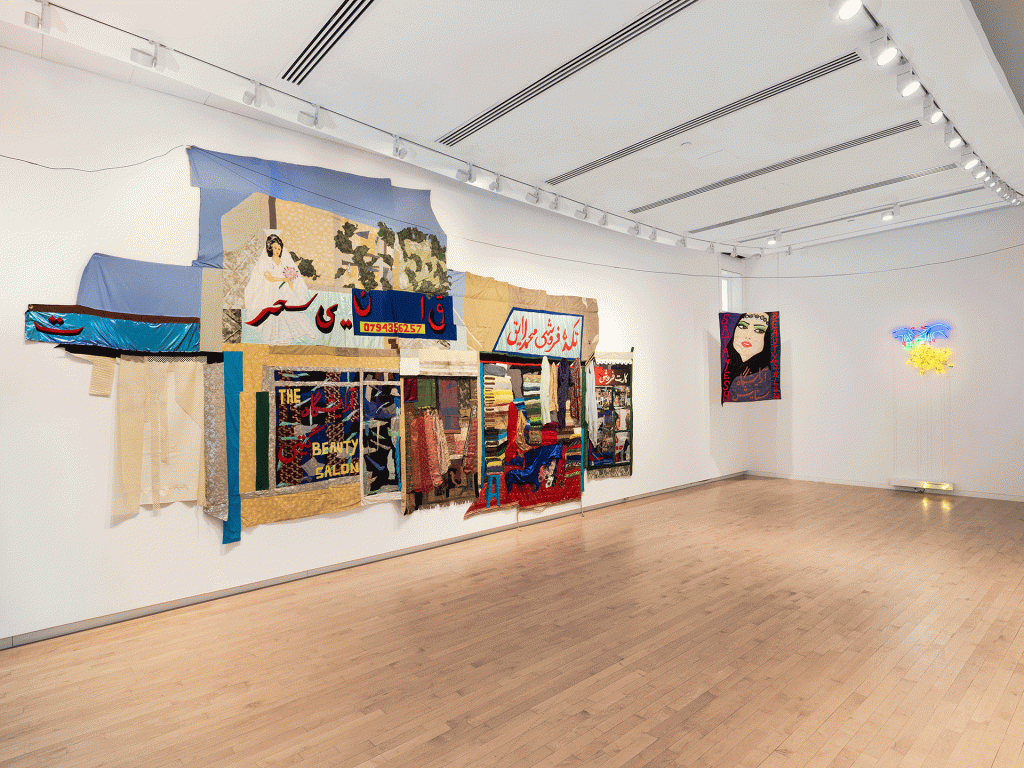
Textile artist Hangama Amiri (BFA 2012) calls New Haven, Connecticut home now, but her roots are inextricably tied to Afghanistan, which she left as a child — spending her teen years in Halifax after nearly a decade in Pakistan and Tajikistan. With the help of Heather Horsfall (BFA 1978), her art teacher at Halifax West High School, she applied to NSCAD with the goal to be a painter.
“She was an amazing teacher and very encouraging of my work,” says Amiri. “I was an immigrant and I didn’t know much about what was going on. I really wanted to learn the painting language, methods, other ways of surface work.”
After receiving her BFA from NSCAD in 2012, Amiri received a Fulbright scholarship which she used to research at and ultimately attend Yale University, where she began focusing on a deeply political, feminist, large-scale textile practice. She completed her Masters in 2020 but has stayed for Yale’s close-knit arts scene, a couple hours outside the creative mecca of New York City. “It looks exactly like Halifax,” says Amiri of New Haven. “It’s a small community far away from a city. That’s my zone, that’s my space.”
Amiri recently had her first solo show “Hangama Amiri: A Homage to Home” at Aldrich Contemporary Art Museum in Ridgefield, Connecticut, which was featured in the New York Times.
Your work is primarily in paint up until 2017, then you started switching to textiles. What precipitated that?
It happened drastically and excitingly at the same time. When I kept looking back at my paintings, the texture I was trying to get was the textiles. I was searching for texture—I needed my work to feel like the world I wanted them to be from. During my graduate time I questioned this content a lot, my material a lot. I thought, let’s start collaging, let’s start bringing the textiles in. It was a period of experimentation, slowly cutting and collaging other fabrics into the canvas. Taking the canvas as a loose canvas as itself, this new genre of art-making. Painting is amazing, but it’s a hard language to have—I’ve always had this battle with it. But I love the idea of cutting and collaging, making imperfect work that’s fragile.
When you moved to the US did you notice a difference in how people talked about and interacted with the work, considering the country’s history with Afghanistan?
I came here first specifically to Yale as a researcher. When I saw the program here, I saw the students were very serious about their practice, the questions were straightforward. Students were not ashamed of what they were doing. The advisors and professors were really curating the work with a critical lens. People are evolved politically—they wanted to engage in conversation even if it was uncomfortable. It’s not that I didn’t have it in Halifax after NSCAD, but it was hard for me to engage in those conversations,. When I was in New Haven among other researchers and artists trying to figure out their identity politics, I could see how my practice would shape-shift.
You make explicitly feminist work, has it always been that way?
I’ve always been interested in the subject of woman. It comes down to how I grew up as a young girl being surrounded by a woman community. Afghanistan is a very gender-based society. I was always around my mom and her friends and aunts, saw what women did and how they navigated their daily lives. During these migration periods my father was not with us. I didn’t grow up with as much paternal love. My mom was hanging out with her friends, she created a supportive agency for herself and for her children. I am very grateful to my mom, raising four children when she was only 30 years old. I’m always interested in the nuances of these daily lives that Afghan women share, no matter where they are. I’m interested to bring those contemporary voices in my work—for them to be seen and heard and have a voice in art history.
The majority of my work really takes the contemporary lens of how I see the world as a woman. When I was making work in 2022, when the fall of Afghanistan happened in August, that time period was really difficult for me. As a diaspora person, away from the place, you feel so helpless. I started creating these bodies of work, got really involved in looking at the access of woman when such a heavy political shift happened. They had some freedom that wasn’t there anymore—they were being removed, erased, defaced. That was a horrifying thing to witness as a diaspora artist from afar. I thought if I don’t make work about this time I have failed myself as an artist. I wanted to be there, in the current time of what was happening. Maybe later on I’ll reflect and wonder, how did I do?
Was there a way in which NSCAD people helped you on your path to the Fulbright or the decision to go to Yale and continue your art practice?
Yes, I was grateful for having advice from my advisors, especially Alex Livingston, Kim Morgan, Karen Cope, and Dr. Jayne Wark, who has been great supporters of my practice and have kindly written me recommendation letters both for my Fulbright Research program and to my grad school application at Yale School of Art. I think following their advice has helped me continue my research and studio practice.

